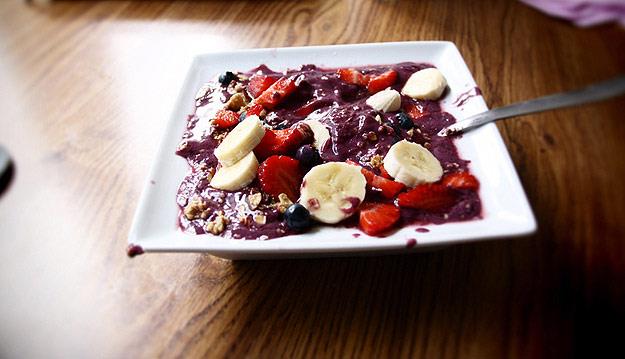Brazil, as a country, is a beautiful blend of colours, languages and customs. Its cuisine too is similarly diverse. The various types of dishes and ingredients used depend on the geographical location within Brazil. Root vegetables are commonly used, and so are fruits that grow well in the tropical and sub-tropical conditions. And they are used extensively, even in savoury cooking. Mangos, papayas (also known as paw paws), guavas, granadillas and pineapples are all firm favourites. These make for some delectable dishes, whether savoury or sweet. Many dishes use rice or beans as a primary ingredient as they are commonly available. Beef, pork and different kinds of fishes and seafood are widely used all over the country. Breakfasts are often fruit-based and energising and lunch is the main meal of the day, hence it is a heavy and elaborate affair. So when in Brazil – feast like the Brazilians!
1. ACAI
Acai are nutritious berries that grow on a species of palm in central and South America. Known as Brazil’s ‘super berries’ they have a bright, sweet flavour and are deep purple in color. One of the best ways to enjoy Acai is to eat them as a frozen puree, almost like sorbet, topped with fresh fruit (typically bananas) and granola. This smoothie in a bowl – cold, sweet, tart, with crunch from the granola – will fill you up, cool you off, and may have all kinds of nutritional and health benefits as well.
2. ACARAJÉ
Acarajé are a speciality of the state of Bahia in Brazil, and a popular street food and beach snack. Black-eyed peas, seasoned with ground dried shrimp and onions, are shaped into fritters and deep fried in palm (dende) oil, then split and filled with various fillings, such as vatapa, or even in a spicy shrimp and onion mixture. Though dried shrimp are a traditional ingredient in acarajé, they tend to impart a very strong flavour. The cooked fritter can be split and then filled with fresh shrimp and caramelized onions for a milder flavour.
3. BEIJINHO DE COCO
These Brazilian coconut candies can be seen at all kind of parties – be it a birthday or a wedding. Beijinhos translates to “little kisses”, and these candies are meant to be bite-size and sweet. There are other similar Brazilian candies in different flavours that are all prepared in a similar method – by cooking sweetened condensed milk until it thickens, but before it caramelises.
4. BRIGADEIROS
Brigadeiros (named after a famous brigadier general) are the chocolate version of this kind of beijinhos. They are like chocolate truffles made with condensed milk instead of cream and covered in chocolate sprinkles. These one bite candies are typically served at parties in pretty paper cups. They are often decorated with a clove in the middle.
5.COXINHA
Coxinha are a Brazilian treat – delicious balls of chicken salad that have been shaped into a drumstick, battered and fried. Easy to eat on the go, and a meal unto themselves.
6.FAROFA
Farofa is a delicious accompaniment to many Brazilian dishes, especially the classic black bean stew feijoada. Farofa is made with manioc flour (harina de mandioca), which is toasted in a skillet with butter, onions and palm oil. It can include egg, bacon, and other add-ons. The root of the manioc (cassava) plant is commonly sold as a very fine starch (almidón), often called tapioca flour in the US.
7.FEIJOADA
Feijoada is one of Brazil’s national treasures. This is a dish that is meant to serve a group and the preparation begins the night before. Several kinds of smoked meats, ribs, and beef jerky are simmered with the black beans. The meat portions are removed and served separately on a platter. The other traditional accompaniments are Brazilian-style rice, collard greens (couve a mineira), farofa (toasted manioc meal), hot pepper sauce, and orange wedges (to help with digestion).
8.MOQUECA DE CAMARAO
Brazilians enjoy many versions of moquecas, or stews, from different regions of the country. This excellent version of fish stew is typical of Bahia, and is prepared with coconut milk and palm oil. Serve it with rice, farofa de dende, afried plaintains. Palm oil (dende oil) adds a special authentic flavour to this dish. You can find palm oil at Brazilian markets and online.
9.QUINDIN
A variety of small individual, petit four-like treats are often served at South American parties. Quindin, a popular coconut treat in Brazil is made with lots of egg yolks, coconut, sugar and butter. It can also be made into one large ring custard. Quindin is baked in a water bath, and the coconut rises to the top while it’s baking. The cakes are then flipped out of the molds to reveal their sparkly golden cap of custard. The coconut becomes the sweet chewy crust.
10.ROMEU-E-JULIETA
Romeu e Julieta in its most basic form is one of the most traditional desserts and the simplest to prepare in the Brazilian culinary repertoire. It consists of a fairly thick slice of fresh white cheese (in Brazil, mostly often queijo minas from the state of Minas Gerais) and an equally thick slice of a fruit paste made from guava (goiaba) called goiabada.




